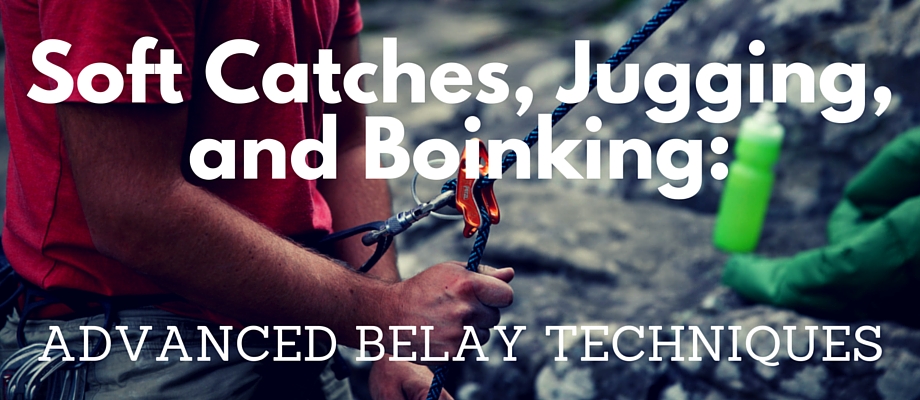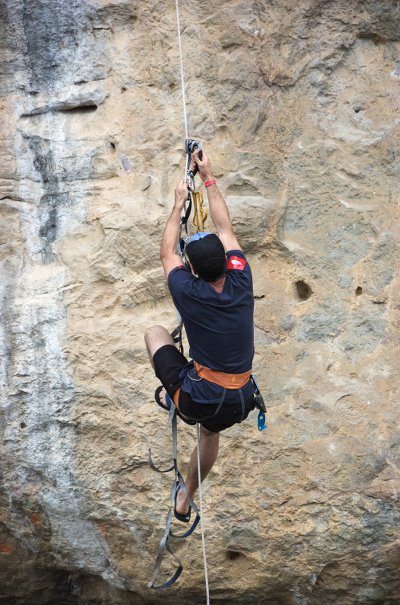
Photo: Ed Dunens
Use this guide as an introduction to advanced belay techniques. For a more fundamental belaying introduction, view Essentials of Belaying. Remember, learning about rock climbing online serves as a tool, but in no way are written articles a substitute for hands-on instruction. Failure to follow appropriate safety measures could result in serious injury or death. If just getting started, seek professional climbing courses offered by AMGA-certified guiding services. Be smart, and climb safe.
Introduction

Pay close attention to the amount of slack in the system when the climber is near the ground or at risk of decking.
Once you and your climbing partners start trying harder climbs, your belaying will get harder as well. As follows there are a few techniques that you need to know to keep your leader safe and happy.
Related: On Being a Good Climbing Partner
Faster, smoother belays
As you get better at belaying, practice movement. It is much easier to take a step towards or away from the wall to either give or take up slack, than it is to move the same amount of rope with your hands only. Familiarize yourself with the area under the climb before your leader leaves the ground, so you can move around fluidly and safely while you belay.
Soft catches for lead belaying
Soft catches are important for two reasons:
- A soft catch feels better for the leader.
- When gear or rock is suspect, soft catches subject the whole system of rope, anchors, and protection to much lower forces.
Many belayers have a tendency to take up slack and sit back as they are catching a fall. This removes precious feet of rope from the system. Remember, your rope is the only part of your whole system that is dynamic (it stretches), and this bad habit effectively snaps the rope tight, which will whip the leader directly back into the wall. This is the opposite of a soft catch.

A soft catch will add comfort to this whipper!
Here’s how to give your leader a nice, soft, comfortable catch:
First, position yourself close to the wall and directly under the first piece of protection. When you notice your leader struggling, or they tell you to watch them, get ready for the soft catch.
Next, crouch where you are and get ready to jump. As they are falling through the air, lock off your brake hand, and just as the rope starts to pull tight, jump!
If you time this well, your leader will slowly come to a stop, which gives them a little more time to brace for the swing back into the wall. As the belayer, you will get pulled up into the air, so be ready to put your feet out and brace against the wall.
Notice that the soft catch does not introduce more slack to the rope; it simply exaggerates rope stretch, decreasing forces on the whole system.
Beware of a few things when practicing soft catches:
Remember to position yourself as close under the first bolt or piece of protection as you can. This way your dynamic belay will launch you up, instead of horizontally into the wall. If there is any risk of your leader hitting the ground, such as when there are long run-outs, or they are not very far off the ground, do not attempt a soft catch. Soft catches are a luxury, and should only be done when it’s safe.
Jugging

A climber jugging up the rope. Photo: Maria Ly
After a lead fall, the leader is effectively on top rope. The rope is going up from the belayer, through the top piece of protection, and back down to the leader. Jugging is when the leader climbs the rope to get back to their highest piece of protection. For jugging to make sense, it has to be easier than climbing. This requires a lot of coordination between both the leader and the belayer.
First, the leader will grab the belayer’s side of the rope (going from the belayer, up through the protection). The leader will position their feet somewhere on the wall, and then pull down on the rope and stand tall, causing some upward progress.
Then, the belayer takes up all of the new slack so that when the leader releases the rope, the leader won’t move down again.
It takes a bit of practice to get the coordination right. Next time you and your partner are top roping, give it a try.
Boinking
Boinking is similar to jugging but is done on extremely overhanging terrain, such as a roof. After the leader has fallen, they likely won’t be able to reach the belayer’s side of the rope since they are hanging in space. Boinking is much more strenuous for the leader, and it’s slower than jugging.
The leader hauls themselves up on their side of the rope, creating a couple of feet of slack (between their hands and their harness). Meanwhile, the belayer keeps as much tension as possible on the rope by leaning back hard.
Once the leader lets go, the tension provided by the belayer should snap the slack out of the system before the leader falls too far. The belayer will fall a little bit, and hopefully retain their balance as the rope snaps tight again.
Boinking is awkward, and should be avoided. If the protection is good (such as a bolt), the leader might try to swing back into the wall so that they can jug up normally.
Alternatively, you can try this “no hands boinking approach”:
Belay devices
It’s worth mentioning that all of the techniques discussed here can be done with any belay device, so long as the belayer is good at using it; however, soft catches, jugging, and good dynamic belaying can be significantly easier and safer with an assisted-breaking device such as a Petzl GriGri.
Again, the most important thing here is that the belayer be competent with their device. For specific use recommendations, see manufacturer provided information.
Need belay-related gear? See our belay and rappel Gear Guide here.
If you enjoyed this post we think you like …
- Climber Confessional: A Learning Experience in How Not to Use a GriGri
- New 2017 Petzl GriGri + (Plus) Review and Comparison
- What Ashima Shiraishi’s 45-Foot Fall Can Teach Us About GriGris








